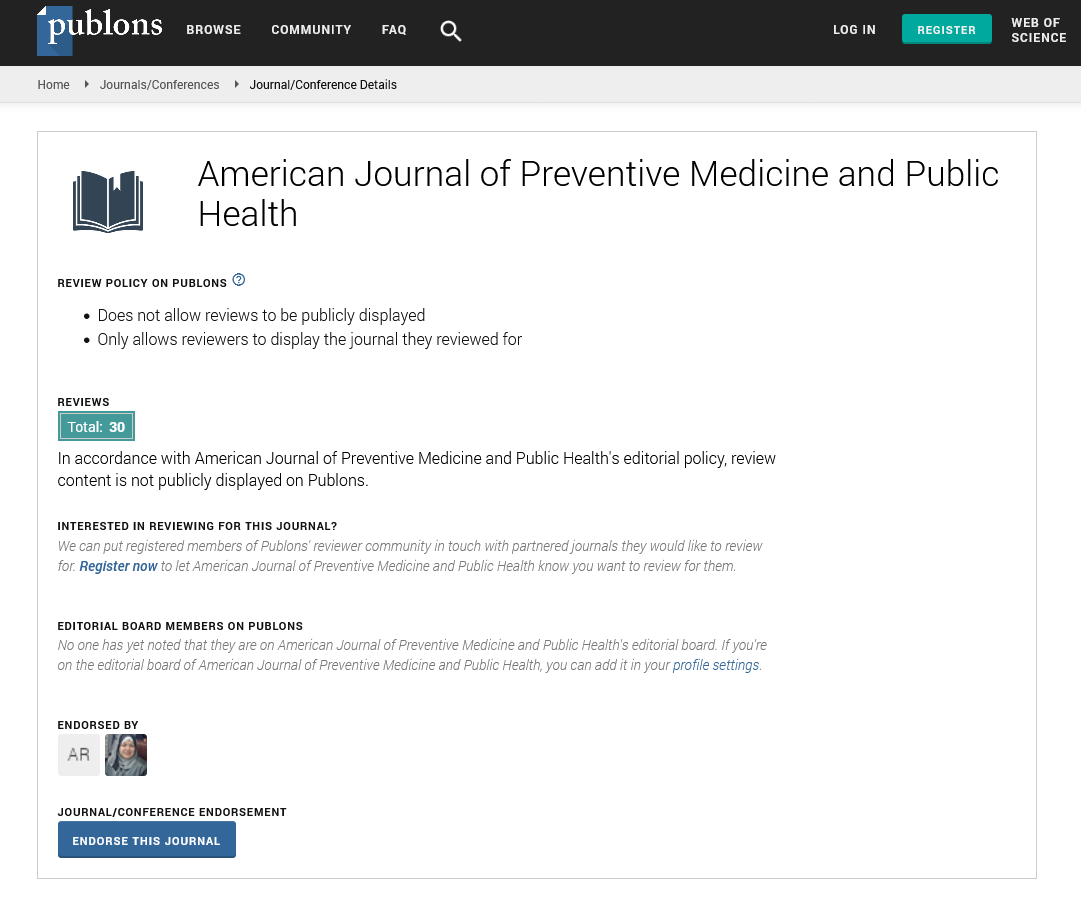Perspective - American Journal of Preventive Medicine and Public Health (2022)
Ebola Virus Disease and Its Diagnosis
Andrea Marzi*Andrea Marzi, Department of Virology, Chair of Microbiology, Jagiellonian University Medical College, Krakow, Poland, Email: andreamarzires@gmail.com
Received: 10-Jun-2022, Manuscript No. AJPMPH-22-70741; Editor assigned: 13-Jun-2022, Pre QC No. AJPMPH-22-70741 (PQ); Reviewed: 28-Jun-2022, QC No. AJPMPH-22-70741; Revised: 04-Jul-2022, Manuscript No. AJPMPH-22-70741 (R); Published: 11-Jul-2022
Description
Ebola is a viral hemorrhagic fever that affects humans and other primates and is brought on by ebolaviruses. It is also referred to as Ebola Virus Disease (EVD) and Ebola Hemorrhagic Fever (EHF). Generally speaking, symptoms appear two days to three weeks after contracting the virus. Fever, sore throat, headaches, and muscle soreness are frequently the first signs of an infection. These are typically followed by nausea, diarrhoea, rash, and a reduction in the function of the liver and kidneys, at which time some persons start to bleed both internally and outwardly. Between 25% and 90% of persons who contract the disease die, or roughly 50% on average. 6 to 16 days after the onset of symptoms, death usually results from shock brought on by fluid loss. Direct contact with body fluids, such as blood from infected humans or other animals, or coming into contact with objects that have recently been contaminated with infected body fluids are the two main ways that the virus spreads. There are no known instances of the disease transmitting between humans or other primates through the air, either in the wild or in a lab setting. Even after an individual recovers from Ebola, the virus may persist in their semen or breast milk for a period of several weeks to many months. Fruit bats are thought to be the virus’ typical natural carrier because they can transfer it without getting sick from it. Ebola symptoms can resemble those of a number of other illnesses, such as cholera, typhoid fever, meningitis, malaria, and other viral hemorrhagic fevers. Blood samples are examined for viral RNA, viral antibodies, or the virus itself to confirm the diagnosis.
Diagnosis
Travel, employment history, and animal exposure are significant considerations when it comes to further diagnostic efforts when EVD is suspected.
Laboratory testing: Low platelet counts, initially decreased white blood cell counts followed by increases in white blood cell counts, elevated levels of the liver enzymes Alanine Aminotransferase (ALT) and Aspartate Aminotransferase (AST), abnormalities in blood clotting that are frequently indicative of Disseminated Intravascular Coagulation (DIC), such as prolonged prothrombin times, partial thromboplastin times, and bleeding times are all potential non-specific laboratory indicators of EVD. In cell cultures observed under electron microscopy, the distinctive filamentous forms of filovirions, such as EBOV, can be used to identify them. By isolating the virus, identifying its RNA or proteins, or identifying antibodies to the virus in a person’s blood, the precise diagnosis of EVD can be established. The methods that work best in the early stages of the disease and for detecting the virus in human remains are cell culture virus isolation, Polymerase Chain Reaction (PCR) virus detection of viral RNA, and Enzyme-Linked Immunosorbent Assay (ELISA) virus detection of viral proteins. The best results for finding anti-virus antibodies are shown in patients who have recovered and in the later stages of the illness. IgG antibodies can be found 6 to 18 days after the onset of symptoms, while IgM antibodies can be found two days after the onset of symptoms. It is frequently impossible to isolate the virus using cell culture techniques during an outbreak.
Differential diagnosis: Early signs of EVD may resemble those of dengue fever and malaria, two illnesses that are widespread in Africa. Additionally, the signs and symptoms resemble those of other viral hemorrhagic fevers as Lassa fever, Crimean-Congo hemorrhagic fever, and Marburg virus disease.
Typhoid fever, shigellosis, rickettsial illnesses, cholera, sepsis, borreliosis, EHEC enteritis, leptospirosis, scrub typhus, plague, Q fever, candidiasis, histoplasmosis, trypanosomiasis, visceral leishmaniasis, measles, and viral hepatitis are only a few examples of the numerous infectious disorders. Acute promyelocytic leukaemia, haemolytic uraemic syndrome, snake venom, thrombotic thrombocytopenic purpura, hereditary hemorrhagic telangiectasia, Kawasaki illness, and warfarin poisoning are a few non-infectious conditions that can cause symptoms that are similar to those of EVD.
Copyright: © 2022 The Authors. This is an open access article under the terms of the Creative Commons Attribution NonCommercial ShareAlike 4.0 (https://creativecommons.org/licenses/by-nc-sa/4.0/). This is an open access article distributed under the terms of the Creative Commons Attribution License, which permits unrestricted use, distribution, and reproduction in any medium, provided the original work is properly cited.







